I have an MPU9250 on my board and I want to change the yaw calculating axis after reboot depending on how this board is placed, like this:
And I thought it would change if I reboot the board, but it doesn't. I'm not very good at this kind of math, but I really hope you can help me.
Here is the code that I use to get φ, θ, ψ. In my main.c loop:
Process_IMU();
q[0] = q0;
q[1] = q1;
q[2] = q2;
q[3] = q3;
a12 = 2.0f * (q[1] * q[2] + q[0] * q[3]);
a22 = q[0] * q[0] + q[1] * q[1] - q[2] * q[2] - q[3] * q[3];
a31 = 2.0f * (q[0] * q[1] + q[2] * q[3]);
a32 = 2.0f * (q[1] * q[3] - q[0] * q[2]);
a33 = q[0] * q[0] - q[1] * q[1] - q[2] * q[2] + q[3] * q[3];
float sinp = a32;
if (abs(sinp) >= 1)
pitch = copysign(M_PI/2,sinp);
else
pitch = asin(sinp);
//pitch = -asinf(a32);
roll = atan2f(a31, a33);
yaw = atan2f(a12, a22) * 2;
pitch *= 180.0f / pi;
yaw = atan2f(sinf(yaw),cosf(yaw));
yaw *= 180.0f / pi;
roll *= 180.0f / pi;
Process_IMU():
void Process_IMU()
{
//read raw data
uint8_t data[14];
uint8_t reg = ACCEL_XOUT_H;
uint8_t mpu_address = MPU9250_ADDRESS_DEFAULT;
while(HAL_I2C_Master_Transmit(_MPU9250_I2C,(uint16_t)mpu_address,®,1,1000) != HAL_OK);
while(HAL_I2C_Master_Receive(_MPU9250_I2C, (uint16_t)mpu_address, data, 14, 1000) != HAL_OK);
/*-------- Accel ---------*/
Accel_x = (int16_t)((int16_t)( data[0] << 8 ) | data[1]);
Accel_y = (int16_t)((int16_t)( data[2] << 8 ) | data[3]);
Accel_z = (int16_t)((int16_t)( data[4] << 8 ) | data[5]);
/*-------- Gyrometer --------*/
Gyro_x = (int16_t)((int16_t)( data[8] << 8 ) | data[9]);
Gyro_y = (int16_t)((int16_t)( data[10] << 8 ) | data[11]);
Gyro_z = (int16_t)((int16_t)( data[12] << 8 ) | data[13]);
Accel_X = 10*(float)((int32_t)Accel_x - Accel_x_bias)/(float)accel_sensitivity;
Accel_Y = 10*(float)((int32_t)Accel_y - Accel_y_bias)/(float)accel_sensitivity;
Accel_Z = 10*(float)((int32_t)Accel_z - Accel_z_bias)/(float)accel_sensitivity ;
Gyro_X = (float)(((int32_t)Gyro_x - Gyro_x_bias)/(float)gyro_sensitivity)*M_PI/180.0f;
Gyro_Y = (float)(((int32_t)Gyro_y - Gyro_y_bias)/(float)gyro_sensitivity)*M_PI/180.0f;
Gyro_Z = (float)(((int32_t)Gyro_z - Gyro_z_bias)/(float)gyro_sensitivity)*M_PI/180.0f;
// Get data of Magnetometer
Get_magnetometer();
MadgwickAHRSupdateFixed(Gyro_X,Gyro_Y,Gyro_Z,Accel_X,Accel_Y,Accel_Z,Mag_X_calib,Mag_Y_calib,-Mag_Z_calib);
}
Get_magnetometer():
void Get_magnetometer()
{
uint8_t raw_data[7];
uint8_t reg_ST1 = ST1;
uint8_t mag_address = MAG_ADDRESS_DEFAULT;
uint8_t reg = XOUT_L;
while(HAL_I2C_Master_Transmit(_MPU9250_I2C,(uint16_t)mag_address,®_ST1,1,1000) != HAL_OK);
while(HAL_I2C_Master_Receive(_MPU9250_I2C,(uint16_t)mag_address,raw_data,1,1000) != HAL_OK);
if (raw_data[0] & 0x01)
{
while(HAL_I2C_Master_Transmit(_MPU9250_I2C,(uint16_t)mag_address,®,1,1000) != HAL_OK);
while(HAL_I2C_Master_Receive(_MPU9250_I2C,(uint16_t)mag_address,raw_data,7,1000) != HAL_OK);
// Read the six raw data and ST2 registers sequentially into data arra
if(!(raw_data[6] & 0x08))// Check if magnetic sensor overflow set, if not then report data
{
Mag_x = (int16_t)((raw_data[1]<<8) | raw_data[0] );
Mag_y = (int16_t)((raw_data[3]<<8) | raw_data[2] );
Mag_z = (int16_t)((raw_data[5]<<8) | raw_data[4] );
}
Mag_X_calib = (float)Mag_x * asax * mag_sensitivity - mag_offset[0];
Mag_Y_calib = (float)Mag_y * asay * mag_sensitivity - mag_offset[1];
Mag_Z_calib = (float)Mag_z * asaz * mag_sensitivity - mag_offset[2];
Mag_X_calib *=scale_x;
Mag_Y_calib *=scale_y;
Mag_Z_calib *=scale_z;
}
}
MadgwickAHRSupdateFixed():
void MadgwickAHRSupdateFixed(float gx, float gy, float gz, float ax, float ay, float az, float mx, float my, float mz) {
float recipNorm;
float s0, s1, s2, s3;
float qDot1, qDot2, qDot3, qDot4;
float hx, hy;
float _2q0mx, _2q0my, _2q0mz, _2q1mx, _2bx, _2bz, _4bx, _4bz, _8bx, _8bz, _2q0, _2q1, _2q2, _2q3, _2q0q2, _2q2q3, q0q0, q0q1, q0q2, q0q3, q1q1, q1q2, q1q3, q2q2, q2q3, q3q3;
// Use IMU algorithm if magnetometer measurement invalid (avoids NaN in magnetometer normalisation)
if((mx == 0.0f) && (my == 0.0f) && (mz == 0.0f)) {
MadgwickAHRSupdateIMU(gx, gy, gz, ax, ay, az);
return;
}
// Rate of change of quaternion from gyroscope
qDot1 = 0.5f * (-q1 * gx - q2 * gy - q3 * gz);
qDot2 = 0.5f * (q0 * gx + q2 * gz - q3 * gy);
qDot3 = 0.5f * (q0 * gy - q1 * gz + q3 * gx);
qDot4 = 0.5f * (q0 * gz + q1 * gy - q2 * gx);
// Compute feedback only if accelerometer measurement valid (avoids NaN in accelerometer normalisation)
if(!((ax == 0.0f) && (ay == 0.0f) && (az == 0.0f))) {
// Normalise accelerometer measurement
recipNorm = invSqrt(ax * ax + ay * ay + az * az);
ax *= recipNorm;
ay *= recipNorm;
az *= recipNorm;
// Normalise magnetometer measurement
recipNorm = invSqrt(mx * mx + my * my + mz * mz);
mx *= recipNorm;
my *= recipNorm;
mz *= recipNorm;
// Auxiliary variables to avoid repeated arithmetic
_2q0mx = 2.0f * q0 * mx;
_2q0my = 2.0f * q0 * my;
_2q0mz = 2.0f * q0 * mz;
_2q1mx = 2.0f * q1 * mx;
_2q0 = 2.0f * q0;
_2q1 = 2.0f * q1;
_2q2 = 2.0f * q2;
_2q3 = 2.0f * q3;
_2q0q2 = 2.0f * q0 * q2;
_2q2q3 = 2.0f * q2 * q3;
q0q0 = q0 * q0;
q0q1 = q0 * q1;
q0q2 = q0 * q2;
q0q3 = q0 * q3;
q1q1 = q1 * q1;
q1q2 = q1 * q2;
q1q3 = q1 * q3;
q2q2 = q2 * q2;
q2q3 = q2 * q3;
q3q3 = q3 * q3;
// Reference direction of Earth's magnetic field
hx = mx * q0q0 - _2q0my * q3 + _2q0mz * q2 + mx * q1q1 + _2q1 * my * q2 + _2q1 * mz * q3 - mx * q2q2 - mx * q3q3;
hy = _2q0mx * q3 + my * q0q0 - _2q0mz * q1 + _2q1mx * q2 - my * q1q1 + my * q2q2 + _2q2 * mz * q3 - my * q3q3;
_2bx = sqrt(hx * hx + hy * hy);
_2bz = -_2q0mx * q2 + _2q0my * q1 + mz * q0q0 + _2q1mx * q3 - mz * q1q1 + _2q2 * my * q3 - mz * q2q2 + mz * q3q3;
_4bx = 2.0f * _2bx;
_4bz = 2.0f * _2bz;
_8bx = 2.0f * _4bx;
_8bz = 2.0f * _4bz;
// Gradient decent algorithm corrective step
s0= -_2q2*(2*(q1q3 - q0q2) - ax) + _2q1*(2*(q0q1 + q2q3) - ay) + -_4bz*q2*(_4bx*(0.5 - q2q2 - q3q3) + _4bz*(q1q3 - q0q2) - mx) + (-_4bx*q3+_4bz*q1)*(_4bx*(q1q2 - q0q3) + _4bz*(q0q1 + q2q3) - my) + _4bx*q2*(_4bx*(q0q2 + q1q3) + _4bz*(0.5 - q1q1 - q2q2) - mz);
s1= _2q3*(2*(q1q3 - q0q2) - ax) + _2q0*(2*(q0q1 + q2q3) - ay) + -4*q1*(2*(0.5 - q1q1 - q2q2) - az) + _4bz*q3*(_4bx*(0.5 - q2q2 - q3q3) + _4bz*(q1q3 - q0q2) - mx) + (_4bx*q2+_4bz*q0)*(_4bx*(q1q2 - q0q3) + _4bz*(q0q1 + q2q3) - my) + (_4bx*q3-_8bz*q1)*(_4bx*(q0q2 + q1q3) + _4bz*(0.5 - q1q1 - q2q2) - mz);
s2= -_2q0*(2*(q1q3 - q0q2) - ax) + _2q3*(2*(q0q1 + q2q3) - ay) + (-4*q2)*(2*(0.5 - q1q1 - q2q2) - az) + (-_8bx*q2-_4bz*q0)*(_4bx*(0.5 - q2q2 - q3q3) + _4bz*(q1q3 - q0q2) - mx)+(_4bx*q1+_4bz*q3)*(_4bx*(q1q2 - q0q3) + _4bz*(q0q1 + q2q3) - my)+(_4bx*q0-_8bz*q2)*(_4bx*(q0q2 + q1q3) + _4bz*(0.5 - q1q1 - q2q2) - mz);
s3= _2q1*(2*(q1q3 - q0q2) - ax) + _2q2*(2*(q0q1 + q2q3) - ay)+(-_8bx*q3+_4bz*q1)*(_4bx*(0.5 - q2q2 - q3q3) + _4bz*(q1q3 - q0q2) - mx)+(-_4bx*q0+_4bz*q2)*(_4bx*(q1q2 - q0q3) + _4bz*(q0q1 + q2q3) - my)+(_4bx*q1)*(_4bx*(q0q2 + q1q3) + _4bz*(0.5 - q1q1 - q2q2) - mz);
recipNorm = invSqrt(s0 * s0 + s1 * s1 + s2 * s2 + s3 * s3); // normalise step magnitude
s0 *= recipNorm;
s1 *= recipNorm;
s2 *= recipNorm;
s3 *= recipNorm;
// Apply feedback step
qDot1 -= beta * s0;
qDot2 -= beta * s1;
qDot3 -= beta * s2;
qDot4 -= beta * s3;
}
// Integrate rate of change of quaternion to yield quaternion
q0 += qDot1 * (1.0f / sampleFreq);
q1 += qDot2 * (1.0f / sampleFreq);
q2 += qDot3 * (1.0f / sampleFreq);
q3 += qDot4 * (1.0f / sampleFreq);
// Normalise quaternion
recipNorm = invSqrt(q0 * q0 + q1 * q1 + q2 * q2 + q3 * q3);
q0 *= recipNorm;
q1 *= recipNorm;
q2 *= recipNorm;
q3 *= recipNorm;
}
I have tried to find information about this, but couldn't. Only this book: https://citeseerx.ist.psu.edu/viewdoc/download?doi=10.1.1.110.5134&rep=rep1&type=pdf but I'm not sure that it will help me. So, the final question is - how to change the yaw calculating axis after board reboot? Thanks for any advice!


